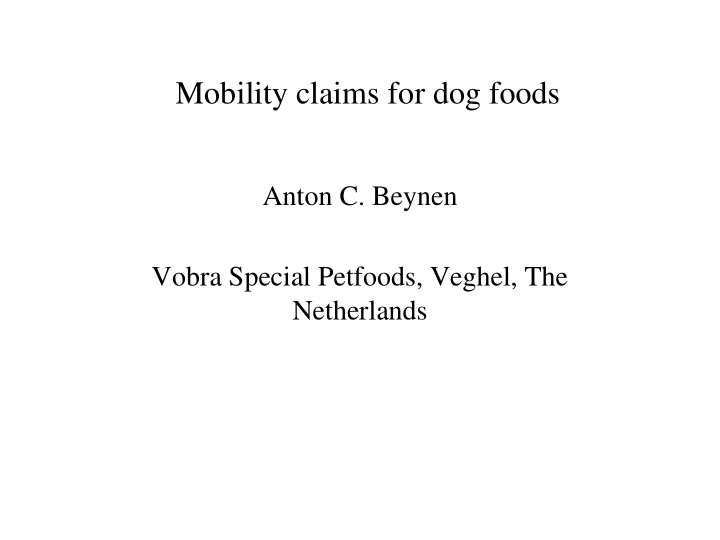



Mobility claims for dog foods Anton C. Beynen Vobra Special Petfoods, Veghel, The Netherlands
Functional foods: mobility dog foods • Health claim • Therapeutic claim
Substances used for canine mobility support • Fish oil • Undenaturated type-II collagen • Gelatin hydrolysate • Curcumin • Beta-1,3/1,6-glucans • Milk protein concentrate • Glucosamine • Methyl sulfonyl methane • Chondroitin sulfate • Devil’s claw • Green-lipped mussel • Green tea • Boswellia resin • Grape skin • Mulberry extract • Vitamin E • Elk velvet antler
Functional ingredients used in mobility dog food • Fish oil • Boswellia resin • Gelatin hydrolysate • Mulberry extract • Beta-1,3/1,6-glucans • Devil’s claw • Glucosamine • Green tea • Chondroitin sulfate • Grape skin • Green-lipped mussel • Curcumin
Clinical signs of osteoarthritis • Lameness • Stiffness • Reduced movement in joint • Reluctance or difficulty with exercise • Crepitus • Painful, warm, swollen joints • Muscle atrophy
Mobility foods with healthy mobility/joint claim • Prevention of joint disease has not (yet) been investigated • Claims are backed by research in canine patients
EU legislation on therapeutic foods for osteoarthritis (Regulation 1070/2010) • Particular nutritional purpose: supporting joint metabolism in case of osteoarthritis • Therapeutic dog food: minimum contents of 3.3% omega-3 fatty acids and 0.38% EPA in dietary dry matter
Placebo effects in trials on canine osteoarthritis • Shown in many studies • Magnitude of placebo effect can be similar to that of corrected treatment effect • Caused by biased evaluation of clinical signs and/or time effects • Non-controlled, open studies are inconclusive
Effective, functional ingredients in the treatment of canine osteoarthritis • Fish oil: weak effect • Gelatin hydrolysate: small effect, but reproducibility unknown • Beta-1,3/1,6-glucans: weak effect, but reproducibility unknown
Perpetuating cycle of osteoarthritis PG Cartilage Synovitis Cytokines degeneration MP release
Basis for dietary treatment of osteoarthritis • Reduction of overweight • Inhibition of inflammation • Preservation of cartilage-matrix
Glucosamine, chondroitin sulfate, green- lipped mussel and curcumin • No evidence for efficacy in the treatment of canine osteoarthtritis • Data evaluation and literature references are available on request: beynen@freeler.nl
Glucosamine and chondroitin sulfate • Substrates for proteoglycan synthesis • Source: crustacean shells and animal cartilage • Absorption efficiency: 11 and 5% • Ineffective in 4 out of 5 double-blind, placebo- controlled trials in osteoarthritic dogs • Dose: 25-61 and 22-48 mg/kg body weight
Green-lipped mussel • Powders, oily extracts • Active principle unknown • Anti-inflammatory action in model systems • No or meaningless effect in 5 double-blind, placebo-controlled trials in osteoarthritic dogs • Dose: 53 or 139 mg/MJ metabolizable energy
Curcumin • Curcuminoid derivatives reduce inflammation and cartilage breakdown in-vitro • No effect on lameness in a double-blind, placebo- controlled trial in osteoarthritic dogs • Induction of skin malodor and yellow coloring of food
Boswellia resin • Active principle: pentacyclic triterpenic (boswellic) acids • In-vitro inhibition of inflammation • One open, non-controlled trial in osteoarthritic dogs
Devil’s claw • Active principle: harpagoside • In-vitro inhibition of inflammation • Anecdotical efficacy in dogs with osteoarthritis
Green tea • Active principle: epigallocacetchin gallate (EGCG) • In-vitro antioxidant activity and inhibition of inflammation • Study in mice with collagen-induced arthritis
Grape skin extract • Active principle: resveratrol • In-vitro antioxidant activity and inhibition of inflammation • Studies in rabbits with LPS-induced arthritis and mice with carrageenan-induced arthritis
Fish oil and canine osteoarthritis • Active principle: EPA • Anti-inflammatory effect • In-vitro inhibition of cartilage proteoglycan catabolism • Four randomized, double-blind, controlled trials have assessed changes over time in severity of clinical signs
Osteoarthritis signs in dogs given fish oil in capsules or diets: improvement effect versus baseline Authors Placebo Fish oil Effect Roush et al., 2010 0.5 0.9 0.4 Hielm-Björkman et al., 2012 0.2 0.3 0.1 Moreau et al., 2013 1.0 1.8 0.8 Mehler et al., 2016 0.1 4.3 4.2 Changes on a (standardized) 0-10 scale
Design of clinical trial (Roush et al., 2010) • Double-blinded, placebo-controlled trial • Client-owned dogs; 16 or 22 per treatment • Dry and canned foods without or with 0.4% EPA on a dry matter basis for 90 days • Assessment by veterinarians of lameness, weight bearing, reluctance to hold up contralateral limb and pain on a 1-5 scale
Improvement versus baseline of clinical osteoarthritis after feeding fish oil (Roush et al. 2010) Pain Hold up leg Fish oil Weight bearing Control Lameness 0 0.5 1 1.5 Effect of fish oil = 0.4 units
Gelatin hydrolysate and canine osteoarthritis • Source: bone and skin of swine and cattle • Supply of substrates for collagen synthesis: glycine, proline, hydroxyproline • Inhibition of matrix metalloproteinase-3 activity
Design of clinical trial with gelatin hydrolysate (Beynen et al., 2010) • Double-blinded, placebo-controlled trial • Privately owned dogs; 15 per treatment • Identical, dry diet • 10 g per day of either gelatin hydrolysate (Rousselot ASF) or soya protein isolate for 8 weeks • Questionnaire (activity, stiffness, lameness, pain on a 0-10 scale)
Improvement versus baseline of clinical osteoarthritis after feeding gelatin hydrolysate Activity Pain Gelatin Stiffness Control Lameness 0 0.5 1 1.5 2 Effect of gelatin hydrolysate = 1.3 units
Effective, functional ingredients in the treatment of canine osteoarthritis • Fish oil: weak effect • Gelatin hydrolysate: small effect, but reproducibility unknown • Beta-1,3/1,6-glucans: weak effect, but reproducibility unknown • Combination might work synergistically
Recommend
More recommend